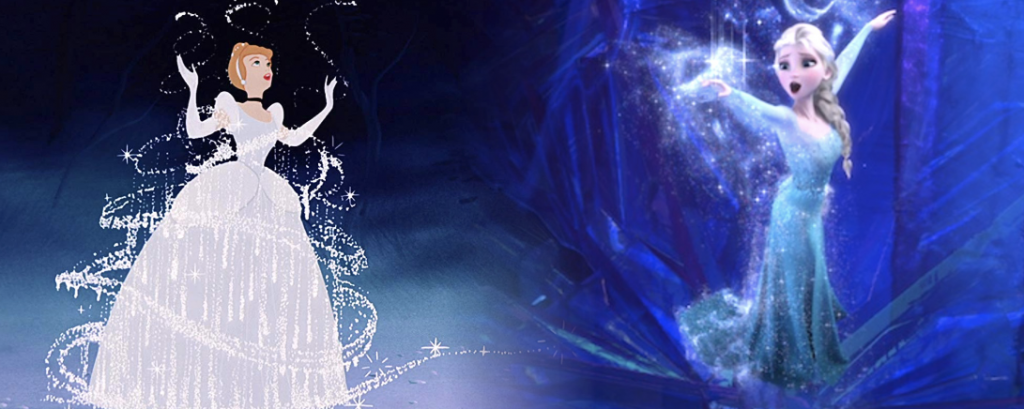Last week the streets in my neighborhood were full of princesses: little girls trick-or-treating from house to house while holding up their spreading skirts. I imagine many of their parents tried to nudge them past the princess aisle at the costume store and toward the superhero or Harry Potter costumes.
But girls will insist, and choosing the right princess is something thoughtful parents take quite seriously. They know that a child is putting on a character, not just a costume, and it’s important to consider the lessons they are buying along with the gauzy skirt.
These lessons have changed over the years, with new characters, like Elsa from the Disney megahit “Frozen,” that present a very different type of princess — and indeed woman — for little girls to learn from. A mom or dad may want to stop and think before helping their daughter choose the new type over the old.
The archetype of early cartoon princesses is another Disney female lead: Cinderella. She is an old-fashioned princess that you would not be far wrong to call a model of Christian maidenhood: gentle and brave, heroically courteous and forgiving.
Like her sisters Snow White and Sleeping Beauty, she is peaceful and cheerfully industrious, responding to oppression with sadness, not anger. And, although docile, Cinderella is also audacious, for it is an act of daring to take her fate into her own hands and attend the ball in disguise. Needless to say, she is chaste and luminously pure.
The classic femininity of the early princesses, their selfless altruism, and glad acceptance of help from a handsome prince, however, has made them unpopular with some modern parents. They view them as victim role models, and prefer a liberated, self-assertive princess with plenty of agency.
Agency, or the capacity of an individual to make his or her own free choices, is notably lacking in Cinderella. Using the feminist lens, she appears to be trapped in the age-old stereotypes of female virtue that have immured women always.
According to this reading, her “goodness” is not a choice; she has been consigned by biology and tradition to altruism as well as passivity. Cinderella’s docility and generosity, and especially her purity, are not only qualities unjustly imposed from the outside but also represent impossible standards.
Holding these virtues up for real girls to imitate is deemed not only silly but damaging, because girls will inevitably transgress, and suffer needless guilt and shame.
Just as damaging an example is Cinderella’s axis of identity, which lies in her relationship to the Other, the Prince, who will finally place her on her feet, yes, but only as a pale reflection of him.
Disney has heard the critiques and has responded by creating princesses with ambiguous moral compasses and inner selves that they let out to play, even to the harm of innocent bystanders. The best example is “Frozen’s” Elsa, an anti-Cinderella in many ways.
Elsa is a princess with the power to freeze everything around her, a power the world around her fears and resents. Unable to control herself, angry at those around her, she selfishly abandons her duty as monarch and sinks her kingdom into an eternal winter. She lashes out against those who would help her, including her loving sister.
The hit song “Let It Go,” which every little girl in America knows by heart, is Elsa’s “cri de cœur.” As she sings “that perfect girl is gone” she releases herself from the stereotypes of good princess, daughter, and sister.
Assuming transcendent agency, she lets it go — “it” being her inner passion — and embraces the results: destruction, isolation, and sterility. But she makes it look attractive, changing into an overtly sexy dress and slamming the door cheekily in the audience’s face.
It is not a stretch for an adult viewer to see this as Elsa coming to terms with her own sexuality, something she is doing without marriage or a prince. But Elsa no longer cares what “they are going to say”: She has reclaimed her identity, including her powers, unjustly stigmatized by a society insisting she be the “perfect girl.”
Elsa is the modern princess, liberated from “noblesse oblige,” the idea that noble birth and privilege are accompanied not by material entitlement but by moral obligation. Like a classic princess, she lives in a castle, wears fine clothes, and dines on gold plates. But unlike a Cinderella or a Snow White, she accepts no constraints on her behavior.
She neither embodies nor seeks moral perfection, and perhaps the deeper message to girls is that there is no such thing.
Parents who are hoping to prepare their girls for a successful adulthood are right to choose carefully their daughters’ role models.
Elsa’s self-assertiveness is attractive, especially in the face of the challenges all women face. But if the rank of princess is measured by nobility and honor, it is Cinderella who lives up to her rank by embodying virtues that make her the better role model for today’s girls.
Self-sacrifice, faithfulness, courageous patience, and mercy are the signs of a true princess, and Cinderella is an excellent teacher. C.S. Lewis put it this way: “Since it is so likely that children will meet cruel enemies, let them at least have heard of brave knights and heroic courage.”

